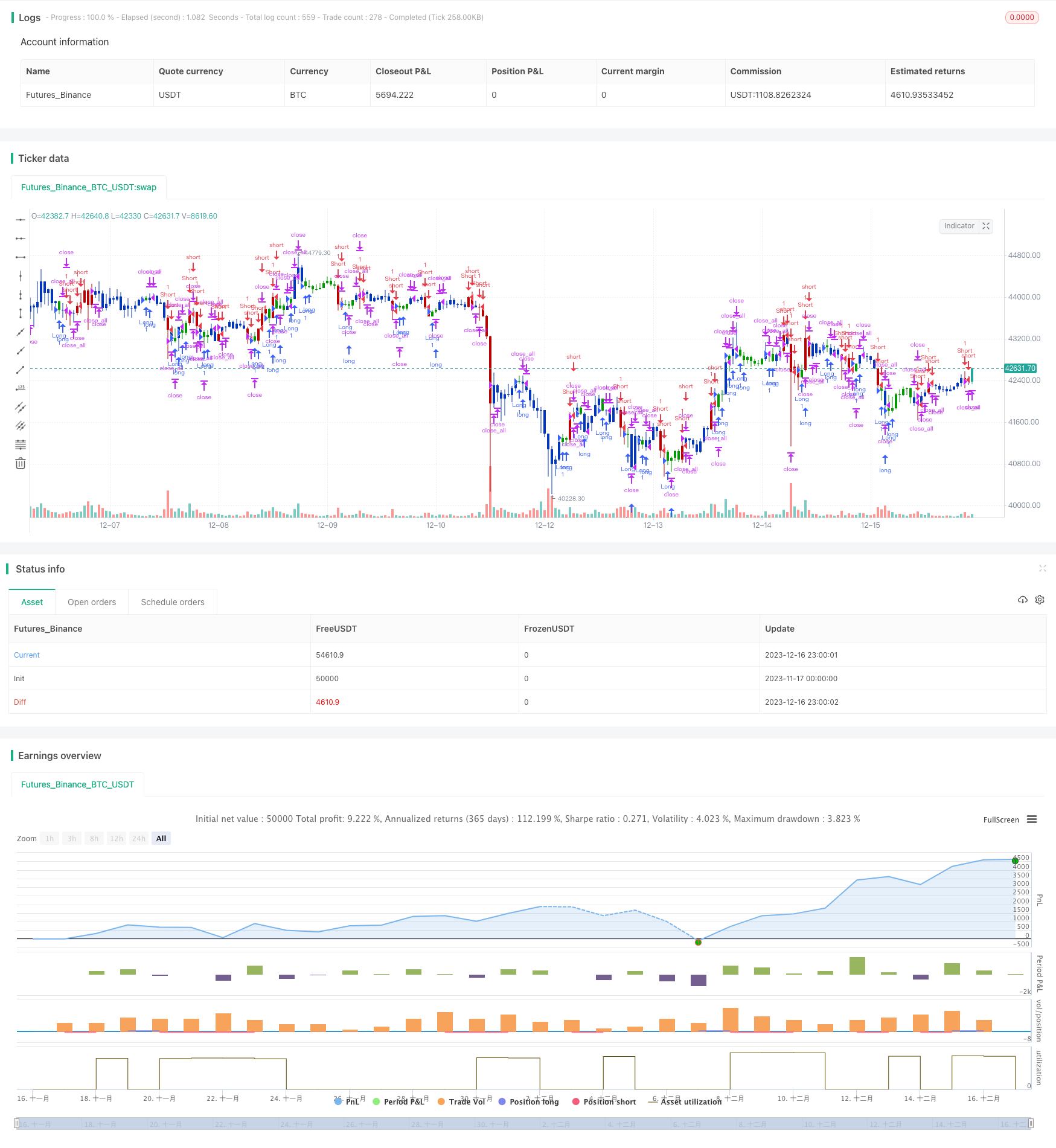
概述
本策略名为“均线指标与价格波动率组合策略”。它结合了双指数移动平均线(Double Exponential Moving Average, DEMA)和价格波动率指标,实现了一个综合交易信号的生成。
策略原理
该策略由两部分组成:
DEMA指标。该指标计算20日和2日的指数移动平均线,当价格从上方向下突破2日线或从下方向上突破20日线时,产生交易信号。
(最高价-最低价)/收盘价波动率指标。该指标反映价格在一个周期内的波动幅度。这里我们计算过去20根K线的波动率指标的16日简单移动平均,当当前K线的波动率高于或低于该平均值时,产生交易信号。
将两组信号结合,如果DEMA和波动率指标同时发出信号,则生成最终的多头或空头交易指令。
优势分析
该策略具有以下优势:
组合多个指标,可以减少假信号,提高信号的可靠性。
20日线能有效识别中长线趋势,2日线能捕捉短期波动,组合使用可以应对不同市场环境。
波动率指标能够有效反映市场的波动性和交易机会。
通过调整参数,可以适应不同品种和周期的市场。
风险分析
该策略也存在一些风险:
在波动率较低的趋势市中,波动率指标可能会产生错误信号。可以结合其他流动性指标进行过滤。
在快速单边行情中,双EMA可能产生滞后。可以适当缩短参数,或与其他指标组合。
多指标组合增加了策略复杂度,也增加了过优化的风险。需进行全面回测和参数稳定性检验。
优化方向
该策略还可以从以下方面进行优化:
增加止损机制,可以有效控制每单损失。
根据不同品种和周期参数进行优化,使参数更具适应性。
增加流动性和波动率指标进行组合,提高信号质量。
增加机器学习算法,实现动态参数和权重调整。
总结
该策略结合双EMA和波动率指标,能够在趋势和震荡市中都获得不错的交易表现。同时也存在一定的风险,需要进一步优化与改进。但总体来说,该策略思路清晰,具有实际操作价值。
策略源码
/*backtest
start: 2023-11-17 00:00:00
end: 2023-12-17 00:00:00
period: 1h
basePeriod: 15m
exchanges: [{"eid":"Futures_Binance","currency":"BTC_USDT"}]
*/
//@version=5
////////////////////////////////////////////////////////////
// Copyright by HPotter v1.0 12/04/2022
// This is combo strategies for get a cumulative signal.
//
// First strategy
// This indicator plots 2/20 exponential moving average. For the Mov
// Avg X 2/20 Indicator, the EMA bar will be painted when the Alert criteria is met.
//
// Second strategy
// This histogram displays (high-low)/close
// Can be applied to any time frame.
//
//
// WARNING:
// - For purpose educate only
// - This script to change bars colors.
////////////////////////////////////////////////////////////
EMA20(Length) =>
pos = 0.0
xPrice = close
xXA = ta.ema(xPrice, Length)
nHH = math.max(high, high[1])
nLL = math.min(low, low[1])
nXS = nLL > xXA or nHH < xXA ? nLL : nHH
iff_1 = nXS < close[1] ? 1 : nz(pos[1], 0)
pos := nXS > close[1] ? -1 : iff_1
pos
HLCH(input_barsback,input_percentorprice,input_smalength) =>
pos = 0.0
xPrice = (high-low)/close
xPriceHL = (high-low)
xPrice1 = input_percentorprice ? xPrice * 100: xPriceHL
xPrice1SMA = ta.sma(math.abs(xPrice1), input_smalength)
pos := xPrice1SMA[input_barsback] > math.abs(xPrice1) ? 1 :
xPrice1SMA[input_barsback] < math.abs(xPrice1) ? -1 : nz(pos[1], 0)
pos
strategy(title='Combo 2/20 EMA & (H-L)/C Histogram', shorttitle='Combo', overlay=true)
var I1 = '●═════ 2/20 EMA ═════●'
Length = input.int(14, minval=1, group=I1)
var I2 = '●═════ (H-L)/C Histogram ═════●'
input_barsback = input(20, title="Look Back", group=I2)
input_percentorprice = input(false, title="% change", group=I2)
input_smalength = input(16, title="SMA Length", group=I2)
var misc = '●═════ MISC ═════●'
reverse = input.bool(false, title='Trade reverse', group=misc)
var timePeriodHeader = '●═════ Time Start ═════●'
d = input.int(1, title='From Day', minval=1, maxval=31, group=timePeriodHeader)
m = input.int(1, title='From Month', minval=1, maxval=12, group=timePeriodHeader)
y = input.int(2005, title='From Year', minval=0, group=timePeriodHeader)
StartTrade = time > timestamp(y, m, d, 00, 00) ? true : false
posEMA20 = EMA20(Length)
prePosHLCH = HLCH(input_barsback,input_percentorprice,input_smalength)
iff_1 = posEMA20 == -1 and prePosHLCH == -1 and StartTrade ? -1 : 0
pos = posEMA20 == 1 and prePosHLCH == 1 and StartTrade ? 1 : iff_1
iff_2 = reverse and pos == -1 ? 1 : pos
possig = reverse and pos == 1 ? -1 : iff_2
if possig == 1
strategy.entry('Long', strategy.long)
if possig == -1
strategy.entry('Short', strategy.short)
if possig == 0
strategy.close_all()
barcolor(possig == -1 ? #b50404 : possig == 1 ? #079605 : #0536b3)